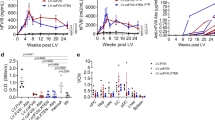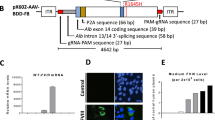Abstract
The canine is the most important large animal model for testing novel hemophilia A (HA) treatment. It is often necessary to use canine factor VIII (cFIII) gene or protein for the evaluation of HA treatment in the canine model. However, different biological properties between cFVIII and human FVIII (hFVIII) indicated that the development of novel HA treatment may require careful characterization of non-human FVIII. To investigate whether the data obtained using cFVIII can translate to HA treatment in human, we analyzed the differential biological properties of canine heavy chain (cHC) and light chain (cLC) by comparing with human heavy chain (hHC) and light chain (hLC). The secretion of cHC was 5–30-fold higher than hHC, with or without light chains (LCs). cHC+hLC group exhibited ~18-fold increase in coagulation activity compared with hHC+hLC delivery by recombinant adeno-associated viral vectors. Unlike hHC, the secretion of cHC was independent of LCs. cLC improves the specific activity of FVIII by two- to threefold compared with hLC. Moreover, the cLC, but not cHC, contributes to the higher stability of cFVIII. Our results suggested that the cFVIII expression results in the canine model should be interpreted with caution as the cHC secreted more efficiently than hHC and cLC exhibited a more active and stable phenotype than hLC.
This is a preview of subscription content, access via your institution
Access options
Subscribe to this journal
Receive 12 print issues and online access
$259.00 per year
only $21.58 per issue
Buy this article
- Purchase on Springer Link
- Instant access to full article PDF
Prices may be subject to local taxes which are calculated during checkout








Similar content being viewed by others
References
Aledort L, Ljung R, Mann K, Pipe S . Factor VIII therapy for hemophilia A: current and future issues. Expert Rev Hematol 2014; 7: 373–385.
Bjorkman S, Berntorp E . Pharmacokinetics of coagulation factors: clinical relevance for patients with haemophilia. Clin Pharmacokinet 2001; 40: 815–832.
Addiego J, Kasper C, Abildgaard C, Hilgartner M, Lusher J, Glader B et al. Frequency of inhibitor development in haemophiliacs treated with low-purity factor VIII. Lancet 1993; 342: 462–464.
Gouw SC, van der Bom JG, Ljung R, Escuriola C, Cid AR, Claeyssens-Donadel S et al. Factor VIII products and inhibitor development in severe hemophilia A. N Engl J Med 2013; 368: 231–239.
Dumont JA, Liu T, Low SC, Zhang X, Kamphaus G, Sakorafas P et al. Prolonged activity of a recombinant factor VIII-Fc fusion protein in hemophilia A mice and dogs. Blood 2012; 119: 3024–3030.
Hermans C, Owens D, Lilley P, Longo G, Morfini M, Lee CA . Single-dose pharmacokinetics of porcine factor VIII (Hyate C). Haemophilia 2002; 8: 33–38.
Tiede A, Brand B, Fischer R, Kavakli K, Lentz SR, Matsushita T et al. Enhancing the pharmacokinetic properties of recombinant factor VIII: first-in-human trial of glycoPEGylated recombinant factor VIII in patients with hemophilia A. J Thromb Haemost 2013; 11: 670–678.
Sabatino DE, Freguia CF, Toso R, Santos A, Merricks EP, Kazazian HH Jr et al. Recombinant canine B-domain-deleted FVIII exhibits high specific activity and is safe in the canine hemophilia A model. Blood 2009; 114: 4562–4565.
Zakas PM, Gangadharan B, Almeida-Porada G, Porada CD, Spencer HT, Doering CB . Development and characterization of recombinant ovine coagulation factor VIII. PLoS One 2012; 7: e49481.
High KH, Nathwani A, Spencer T, Lillicrap D . Current status of haemophilia gene therapy. Haemophilia 2014; 20: 43–49.
High KA . The gene therapy journey for hemophilia: are we there yet? Blood 2012; 120: 4482–4487.
Fomin ME, Togarrati PP, Muench MO . Progress and challenges in the development of a cell-based therapy for hemophilia A. J Thromb Haemost 2014; 12: 1954–1965.
Jiang H, Lillicrap D, Patarroyo-White S, Liu T, Qian X, Scallan CD et al. Multiyear therapeutic benefit of AAV serotypes 2, 6, and 8 delivering factor VIII to hemophilia A mice and dogs. Blood 2006; 108: 107–115.
Chen L, Zhu F, Li J, Lu H, Jiang H, Sarkar R et al. The enhancing effects of the light chain on heavy chain secretion in split delivery of factor VIII gene. Mol Ther 2007; 15: 1856–1862.
Lu H, Chen L, Wang J, Huack B, Sarkar R, Zhou S et al. Complete correction of hemophilia A with adeno-associated viral vectors containing a full-size expression cassette. Hum Gene Ther 2008; 19: 648–654.
Chen L, Lu H, Wang J, Sarkar R, Yang X, Wang H et al. Enhanced factor VIII heavy chain for gene therapy of hemophilia A. Mol Ther 2009; 17: 417–424.
Siner JI, Iacobelli NP, Sabatino DE, Ivanciu L, Zhou S, Poncz M et al. Minimal modification in the factor VIII B-domain sequence ameliorates the murine hemophilia A phenotype. Blood 2013; 121: 4396–4403.
McIntosh J, Lenting PJ, Rosales C, Lee D, Rabbanian S, Raj D et al. Therapeutic levels of FVIII following a single peripheral vein administration of rAAV vector encoding a novel human factor VIII variant. Blood 2013; 121: 3335–3344.
Gnatenko DV, Saenko EL, Jesty J, Cao LX, Hearing P, Bahou WF . Human factor VIII can be packaged and functionally expressed in an adeno-associated virus background: applicability to haemophilia A gene therapy. Br J Haematol 1999; 104: 27–36.
Sabatino DE, Nichols TC, Merricks E, Bellinger DA, Herzog RW, Monahan PE . Animal models of hemophilia. Prog Mol Biol Transl Sci 2012; 105: 151–209.
Sabatino DE, Lange AM, Altynova ES, Sarkar R, Zhou S, Merricks EP et al. Efficacy and safety of long-term prophylaxis in severe hemophilia A dogs following liver gene therapy using AAV vectors. Mol Ther 2011; 19: 442–449.
Gallo-Penn AM, Shirley PS, Andrews JL, Kayda DB, Pinkstaff AM, Kaloss M et al. In vivo evaluation of an adenoviral vector encoding canine factor VIII: high-level, sustained expression in hemophiliac mice. Hum Gene Ther 1999; 10: 1791–1802.
Doering CB, Healey JF, Parker ET, Barrow RT, Lollar P . High level expression of recombinant porcine coagulation factor VIII. J Biol Chem 2002; 277: 38345–38349.
Doering CB, Healey JF, Parker ET, Barrow RT, Lollar P . Identification of porcine coagulation factor VIII domains responsible for high level expression via enhanced secretion. J Biol Chem 2004; 279: 6546–6552.
Sarkar R, Xiao W, Kazazian HH Jr . A single adeno-associated virus (AAV)-murine factor VIII vector partially corrects the hemophilia A phenotype. J Thromb Haemost 2003; 1: 220–226.
Sarkar R, Tetreault R, Gao G, Wang L, Bell P, Chandler R et al. Total correction of hemophilia A mice with canine FVIII using an AAV 8 serotype. Blood 2004; 103: 1253–1260.
Scallan CD, Lillicrap D, Jiang H, Qian X, Patarroyo-White SL, Parker AE et al. Sustained phenotypic correction of canine hemophilia A using an adeno-associated viral vector. Blood 2003; 102: 2031–2037.
Scallan CD, Liu T, Parker AE, Patarroyo-White SL, Chen H, Jiang H et al. Phenotypic correction of a mouse model of hemophilia A using AAV2 vectors encoding the heavy and light chains of FVIII. Blood 2003; 102: 3919–3926.
Burton M, Nakai H, Colosi P, Cunningham J, Mitchell R, Couto L . Coexpression of factor VIII heavy and light chain adeno-associated viral vectors produces biologically active protein. Proc Natl Acad Sci USA 1999; 96: 12725–12730.
Dooriss KL, Denning G, Gangadharan B, Javazon EH, McCarty DA, Spencer HT et al. Comparison of factor VIII transgenes bioengineered for improved expression in gene therapy of hemophilia A. Hum Gene Ther 2009; 20: 465–478.
Wang Q, Dong B, Firrman J, Roberts S, Moore AR, Cao W et al. Efficient production of dual recombinant adeno-associated viral vectors for factor VIII delivery. Hum Gene Ther Methods 2014; 25: 261–268.
Dong B, Nakai H, Xiao W . Characterization of genome integrity for oversized recombinant AAV vector. Mol Ther 2010; 18: 87–92.
Acknowledgements
This work was supported by National Institutes of Health (NIH) (R01HL114152 and R01HL080789 to WX). The work was also supported in part by grant funding from Novo Nordisk Haemophilia Research Fund (NNHRF) China.
Author information
Authors and Affiliations
Corresponding author
Ethics declarations
Competing interests
The authors declare no conflict of interest.
Rights and permissions
About this article
Cite this article
Wang, Q., Dong, B., Firrman, J. et al. Evaluation of the biological differences of canine and human factor VIII in gene delivery: implications in human hemophilia treatment. Gene Ther 23, 597–605 (2016). https://doi.org/10.1038/gt.2016.34
Received:
Revised:
Accepted:
Published:
Issue Date:
DOI: https://doi.org/10.1038/gt.2016.34



